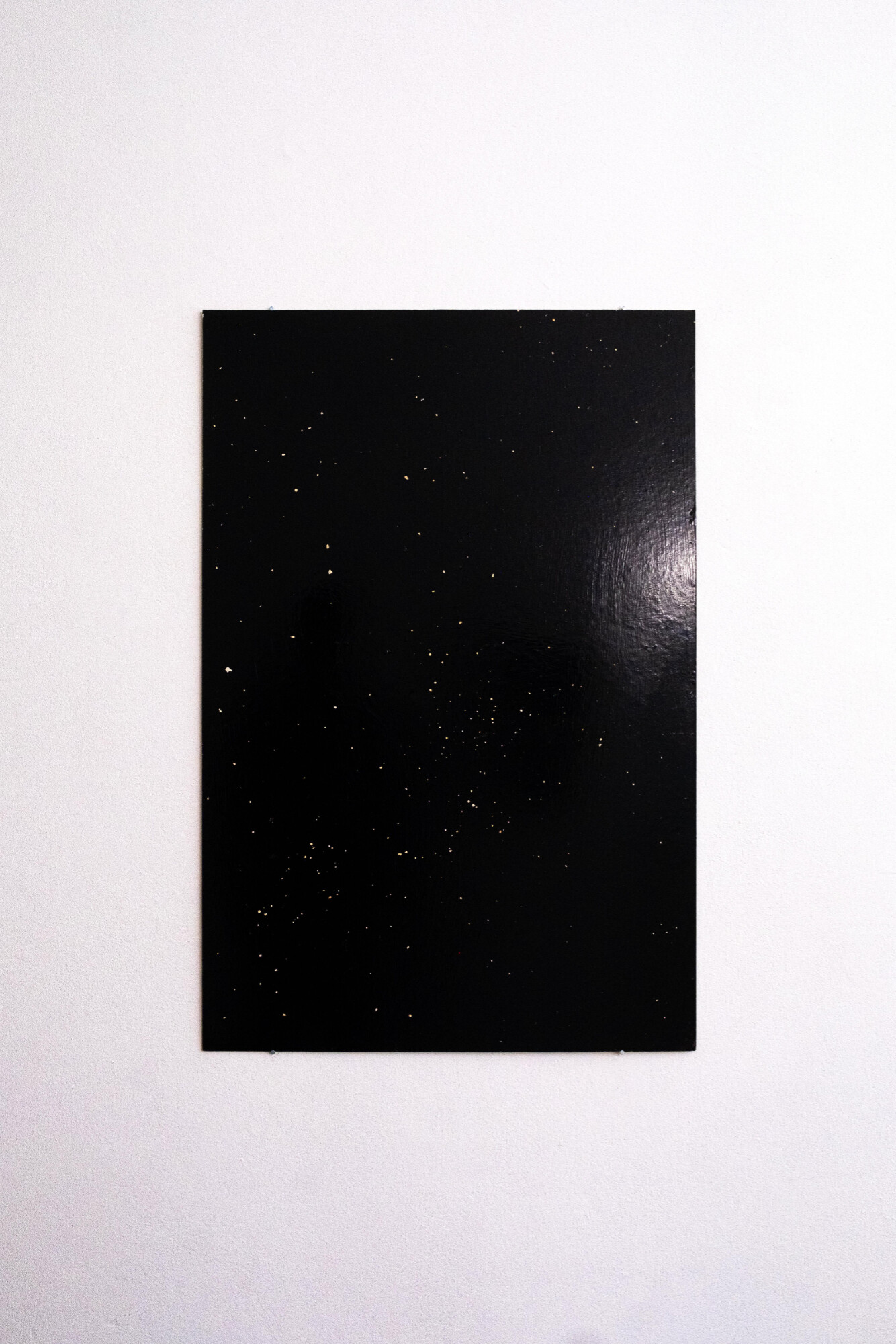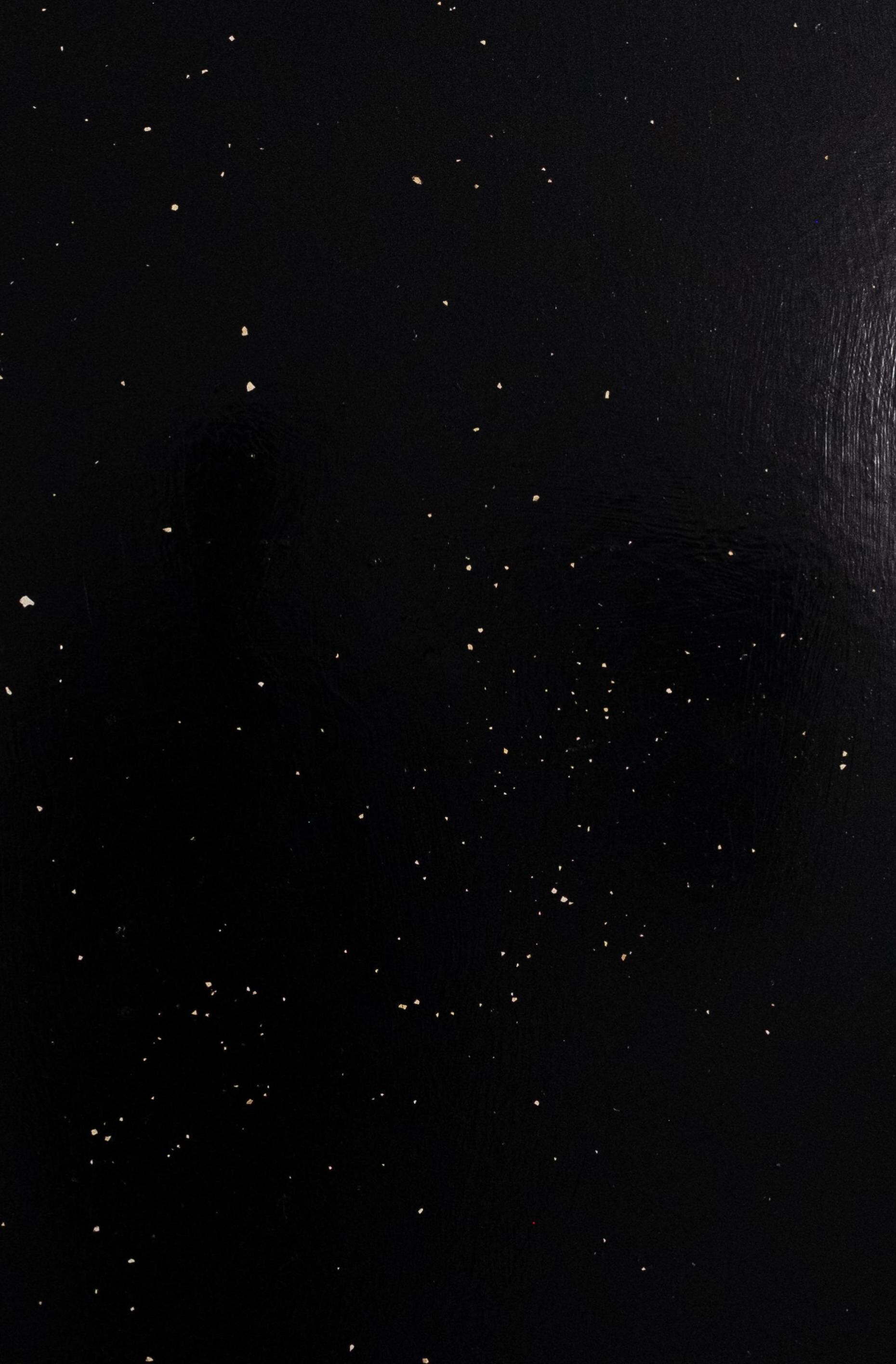Detail of Untitled (Starry Night), 1986, eggshell and enamel on plywood, 51 x 40.5 cm. Courtesy of The Estate of John Nixon, and Anna Schwartz Gallery, Melbourne. Photo: Timilehin Tolulope Akindoyeni.
John Nixon: Eggshell Paintings
Brian Obiri-Asare
I don’t experience it much now, the night sky of central Australia, where the stars sparkle and fill up the dark, and long before you drift off to sleep in your swag you can taste the mystery with your eyes, can feel the majesty above you—and even in you—which seems to widen the world, to make it a little larger. And if you were lucky, a shooting star would add to the wonder, and you would make a wish, and feel a touch closer to the transcendent. Living in Sydney now, the night sky don’t hit the same. Yet there are times when I close my eyes and I’m back in central Australia and I see all these stars shining in a bright abyss.

Untitled (Starry Night), 1986, eggshell and enamel on plywood, 51 x 40.5 cm. Courtesy of The Estate of John Nixon, and Anna Schwartz Gallery, Melbourne. Photo: Timilehin Tolulope Akindoyeni.
And fortunately, there are also other times where, thanks to art, that precious capacity for creative abstraction available to us all, I don’t need to have my eyes wide shut to be transported. I’m free to follow in the footsteps of where artists choose to lead. Some intellectualise their creativity, bury it under a fog of jargon, a barrage of pseudo-intellectual verbosity. Some play self-consciously revolutionary games, full of sound and fury, signifying nothing. Some attempt to help people with their struggles. And for some, art isn’t an intellectual, rational, or utilitarian endeavour. Rather, it’s a human response to the totality of an instance of observation filled with all its related mystery. It comes from a place more imponderable, more peculiar than any theory, or style, or passing fashion, where the artist is as much under the spell of the muses as the master of their craft. It’s almost as if such artists have no choice but to compulsively, manically keep trying to do what they do.
A cat like John Nixon chills in this later space. Chatting with a friend who knew the guy, she stressed his devotion—veering on an almost religious adherence—to craft. He was the most disciplined artist she knew. With his paintings, but one tiny portion of an expansive practice, he sought to root abstraction in the reality of life’s poetry. Advertising, TV, magazines, films, records, clothes, muzak, supermarkets, newspapers, sport, and discos were all grist for his mill. He tried to absorb it all. The cat also believed in something. I gleaned as much listening to a SoundCloud recording she sent me of him lecturing a hushed audience about the necessity of an artist’s commitment to history, to craft, to exploration, to questioning. The guy was a Don. And his reputation, since his passing, weighs heavy over certain circles.
It was with a mix of curiosity and expectation that I made my way to Sydney Sydney gallery to see John Nixon’s eggshell paintings. It was mid-morning, the sun was out and about, and Sydney was all blue sky and sparkly verve, on its way to another belter. The beach was calling. I had started the morning out at the Art Gallery of New South Wales, wanting to catch an Ian Fairweather piece I last remembered seeing on the ground floor, but the crowd swarming inside, hankering for some Magritte and Cao Fei, was too distracting. A leisurely stroll outside, along the harbour and up to Potts Point, held more appeal.
At Sydney Sydney, artist, curator and director Connor O’Shea provides a homely space to view selected works of contemporary international and Australian art. You get to see a practice up close, in the lounge room of an art deco apartment. It’s chill and lacking pretence. There’s room and space to ponder, to daydream, and to consider the sunlight as it streams through the leafy trees on Macleay St, through the apartment’s glass windows, and brightens the work on display.

Detail of Untitled (Starry Night), 1986, eggshell and enamel on plywood, 51 x 40.5 cm. Courtesy of The Estate of John Nixon, and Anna Schwartz Gallery, Melbourne. Photo: Timilehin Tolulope Akindoyeni.
John’s paintings hover on two white walls. On one, glossy black enamel coats two rectangular pieces of Masonite and one of plywood. Tiny flecks of cream eggshells either adhere to the surface or sink into the black, adding to an already bumpy texture. With John’s abstracting brush, the paint has been applied in a direct and economic manner. The eggshells, carefully cracked and set aside for the purpose of these works, are scattered across the plywood and Masonite in a similarly pragmatic manner. On the other wall, the same glossy black, the same scattering of eggshells. There are two paintings here. Cardboard provides the support for one, plywood the other.
Taken together, the works are affecting in their simplicity. There are no tricks, no illusions. Just paint, eggshells, and Masonite, plywood, or cardboard. You’re given a surface, an impetus for staring into a starry night, at constellations made with humble, natural materials. The paintings aren’t perfect abstract marvels. There’s something uneven to them, something even a touch untidy, and that’s ok. Their beauty is more austere, suggestive of a refinement of process and ideation. It’s almost like many, many years ago, John came up with a way of limiting and thereby intensifying the possibilities of painting, of synthesising ideas through materials, of using abstraction as a release for the imagination, and couldn’t help but keep refining and experimenting and refining some more.
I don’t know nothing about the night sky John saw, or drew from, when he made these eggshell paintings. It was the mid-to-late ‘80s, a bit before my time, but I do know his head was swimming in abstract ideas. As a young man, he had been profoundly influenced by the Marcel Duchamp retrospective exhibition he saw at the National Gallery of Victoria in the late ‘60s. And in John, the radical modernisms of Arte Povera and Russian Constructivism found an assiduous disciple. By the ‘80s, he was well on his way to experimenting and exploring the threads these radicalisms bequeathed him, fostering contemporaneous exchanges with, and adding a local flavour to, far-flung movements we sometimes, in Australia, mistakenly understand ourselves to be standing outside of. When he made the eggshell paintings, he was also already an institutional darling, his oppositionality normalised. He had already founded the gallery Art Projects in Melbourne. He had already served two years as the director of the Institute of Modern Art in Brisbane. And he had already represented Australia at Documenta 7, in Kassel, Germany, with his good mate and sometime collaborator, Imants Tillers.
This is all to say that the sky John conjures with his eggshell paintings bears the strong imprint of his milieu. The poetry evoked is somewhat limited by the dogmatic emphasis on surface, on materiality, on the technical simplicity of the art object. There’s no disorder. The wonder is muted, hinted at. There’s no room for the immaterial, for other, older, less modern, more spiritual ontologies. Not that that was what he was even aiming for or at. It’s just an absence that rings loud. Just like how his abstracting touch, rooted in the fetishisation of the everyday, rings a little quaint. There’s something so impractical, so wonderfully delusional, about his attempts to collapse the distinction between art and the detritus of daily life, of which his eggshell paintings serve as telling examples.
John was a serious man. He was a native plant allowed to grow freely. He chased the muse. But, most importantly, at the end of the day, he was an artist. He was driven by inner necessity. A necessity that involved wrestling—with ideas, with concepts, with materials, with life. The results weren’t always works of stunning technical virtuosity. Indeed, the eggshell paintings on display at Sydney Sydney point elsewhere. They show an artist compelled to do, over and over, day after day, whatever it is he had to do, hoping it would come out better each time. They had the mark of something real and very much alive.
In the days after seeing the John Nixon show I made an effort to look up at the stars before bed each night. One night it rained. One night there was too much cloud. And on one, I could make out a couple of stars. It was nothing like the sky of central Australia. Made me wonder what John held onto when he looked up at the stars all those years ago in Melbourne.
Brian Obiri-Asare is a writer currently based in Sydney.